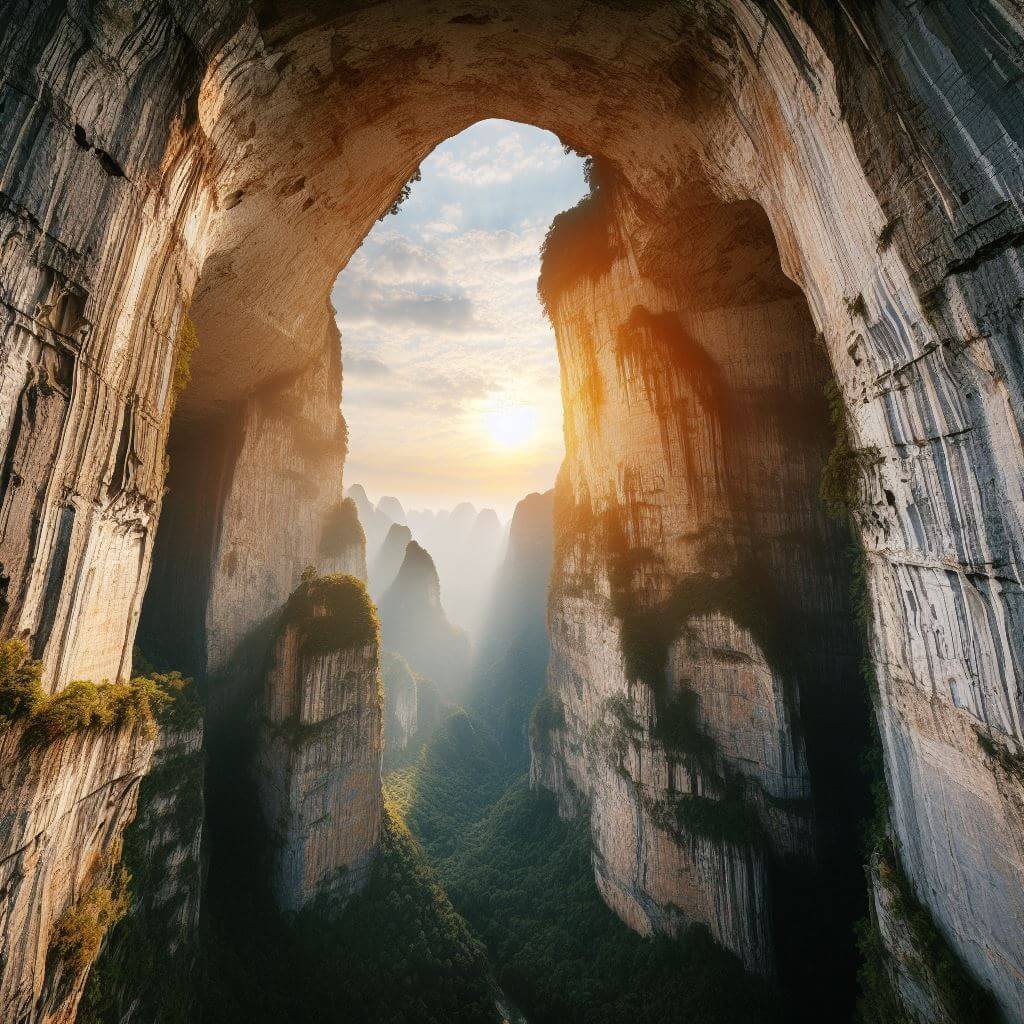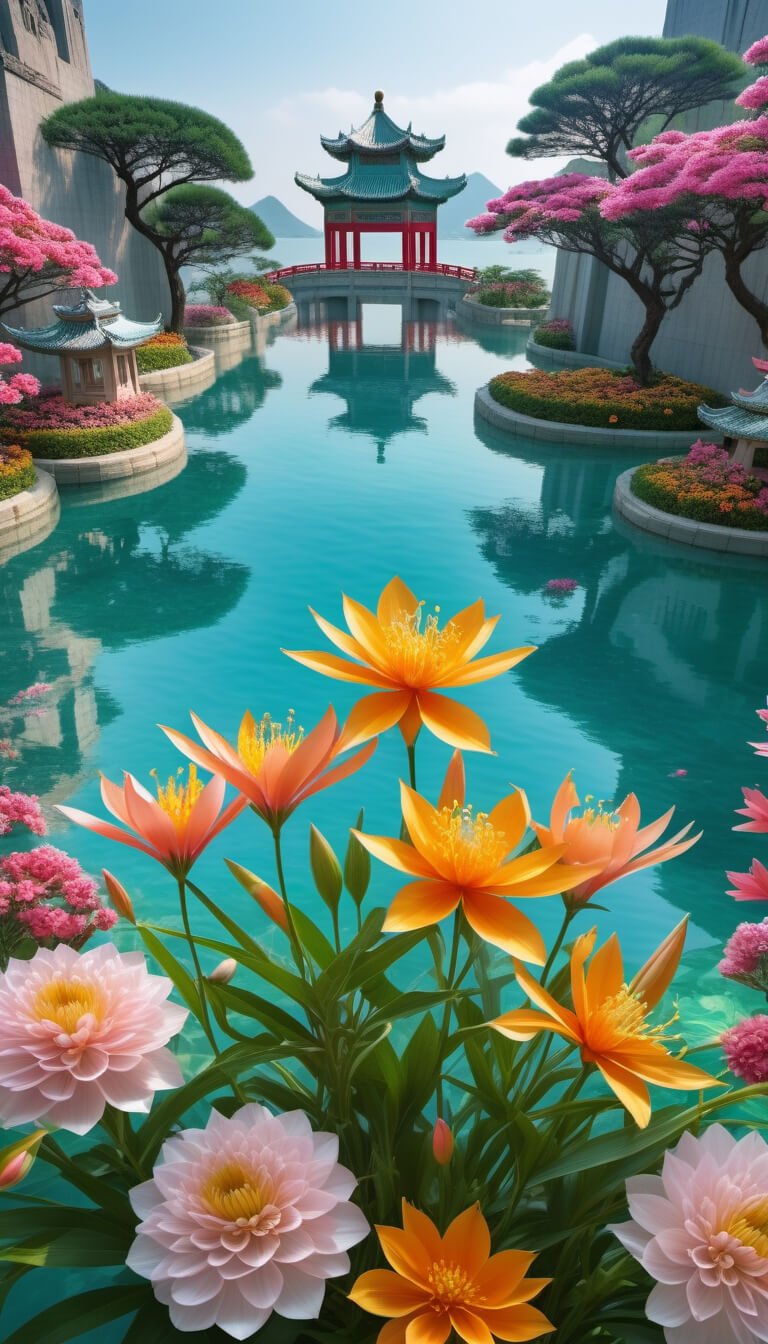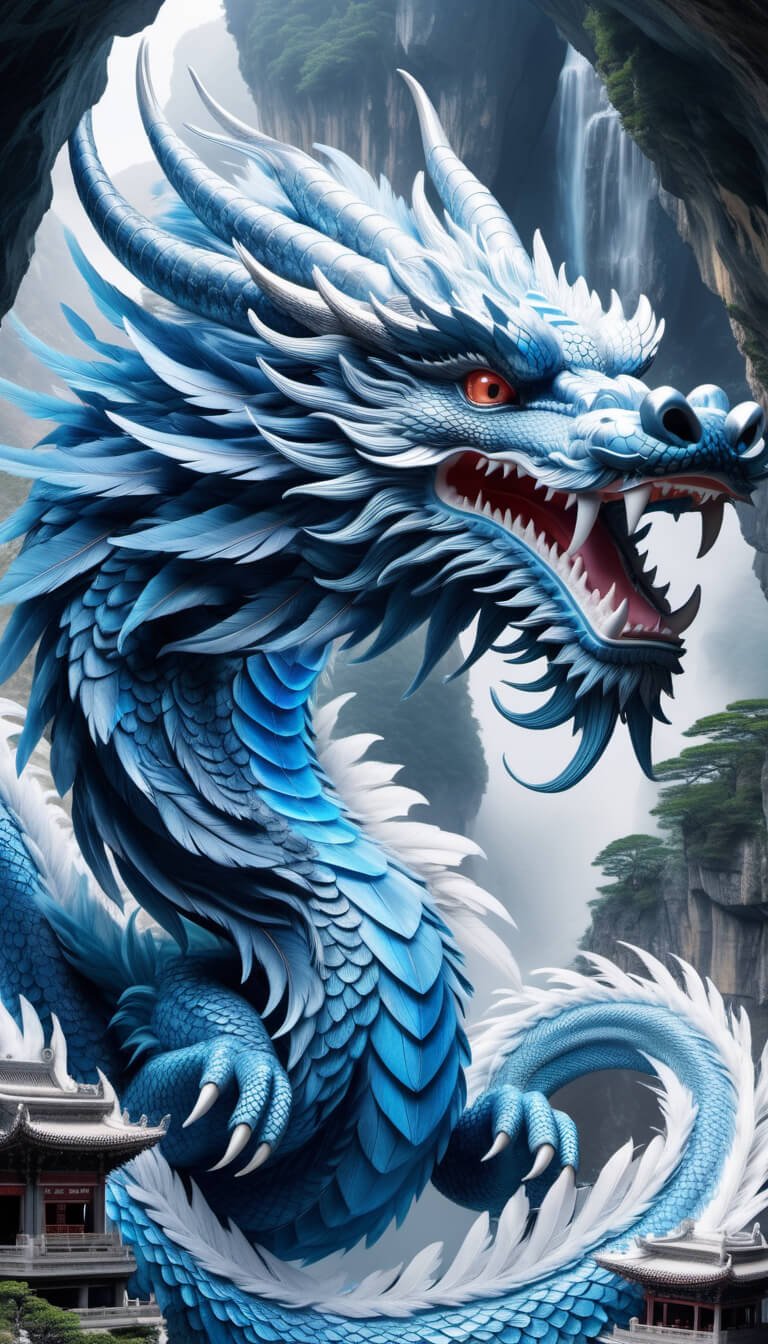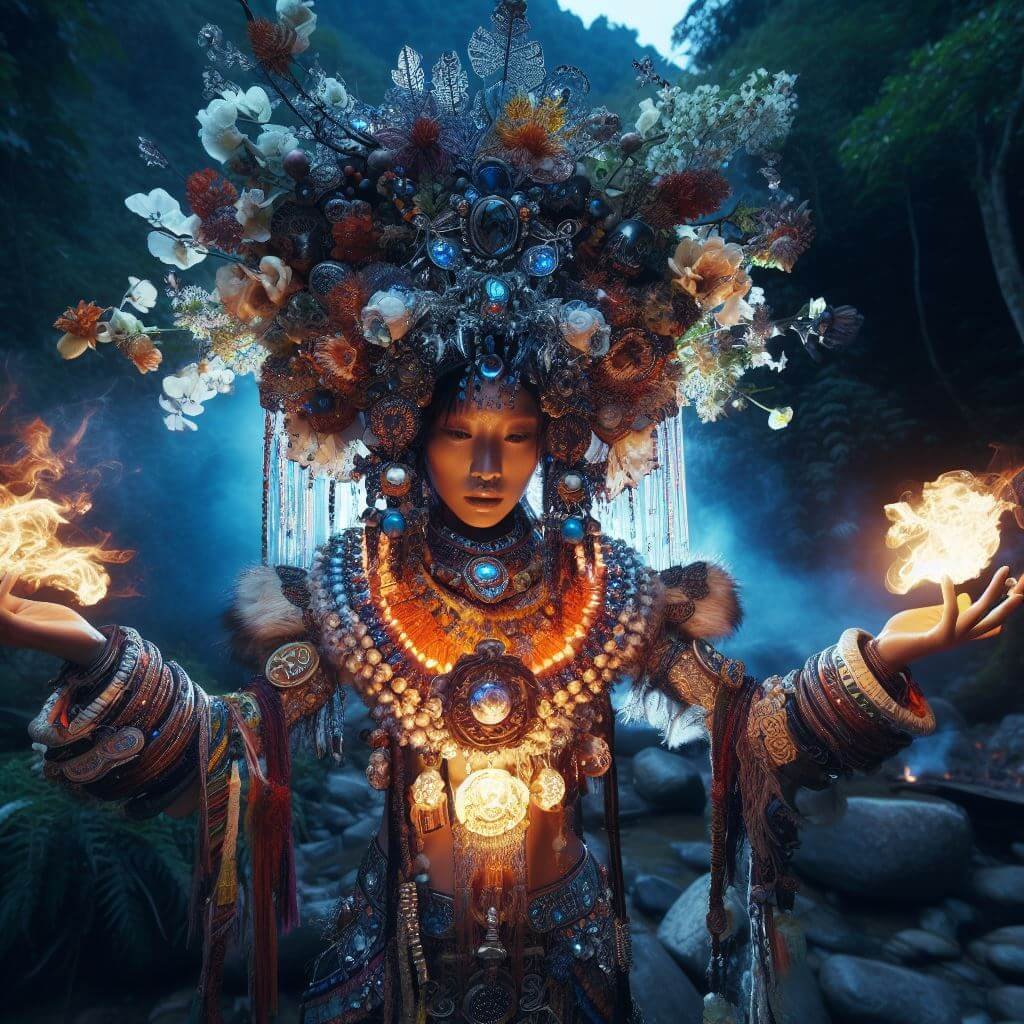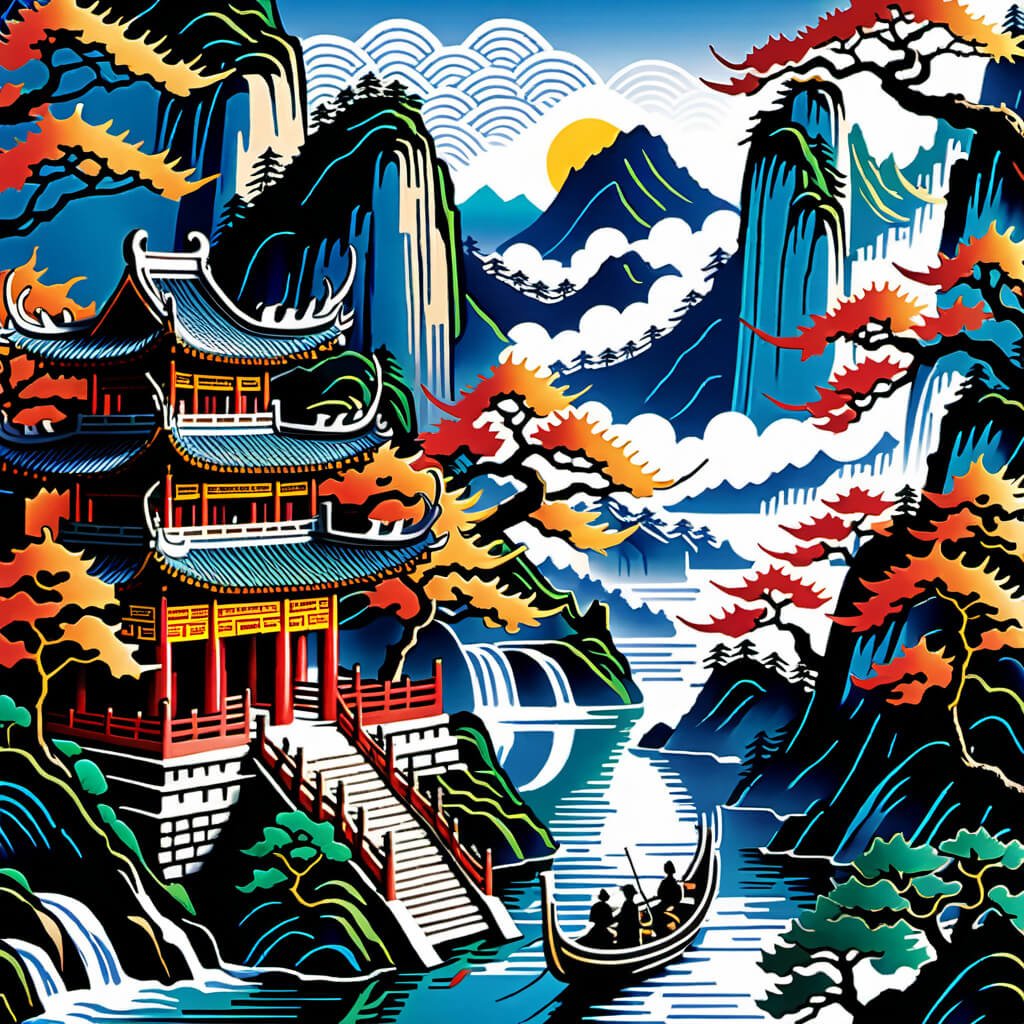Tianmen Cave: China's Breathtaking "Gateway to Heaven"
An Interdisciplinary Analysis of China’s Tianmen Cave: History, Lore, Geography, Ecology and Cultural Significance
Key Takeaways:
Formed by natural erosion, Tianmen Cave is a towering karst arch 131m high piercing misty peaks in China's Hunan Province
The iconic "Heaven's Gate" site inspires awe through geological spectacle and spiritual symbolism
Tianmen Cave overlooks the old growth Wulingyuan cloud forests - a biodiversity and conservation hotspot
Local myths date to ancient tribes and feature deities like Nüwa ascending into paradise through Tianmen's veiled gateway
Dong, Tujia and Miao minority groups surround Tianmen Mountain interweaving its stunning scenery with their cultural identities
Booming tourism now threatens fragile environments and heritage around the sacred cave
Recent sustainable visitor caps and planning help safeguard Tianmen's enchanting landscapes for future generations
Tianmen Cave, known as the “Gateway to Heaven”, is a towering natural karst arch located in northwestern Hunan Province, China. Formed within limestone cliffs rising 200-300 meters, the cave stands 131.5 meters tall and 57 meters wide (Xiong, 2009). Part of Zhangjiajie National Forest Park within the Wulingyuan Scenic Area, Tianmen Cave has drawn visitors for centuries with its geological spectacle and deep cultural lore.
Rising out of lush subtropical forest in China’s Hunan Province, the breathtaking natural arch of Tianmen Cave punctures mist-shrouded cliffs thought to reach between heaven and earth. This towering karst feature wears many mantles – geologic spectacle, ecological oasis, sacred site, and now threatened tourism hotspot.
Formed over millions of years by natural processes, Tianmen Cave’s name promises deeper meanings as “Heaven’s Gate,” evoking cloud-veiled landscapes depicted in classical Chinese ink wash paintings (UNESCO, 2022). Beyond stunning geology and scenery, the cave grounds identities, faiths and livelihoods for diverse surrounding populations. This paper will highlight insights into Tianmen Cave’s natural wonders, complex human connections and urgent conservation needs.
Eastern China shelters astonishing biodiversity within its temperate, subtropical and tropical ecosystems – much already lost elsewhere in the country (Liu et al., 2003). Tianmen Cave presides over a 250 km2 patch of rare, precious native forest.
The adjacent Wulingyuan Scenic Area safeguards nearly 3,000 quartzite spires along with the rich wildlife found nowhere else (Xiong, 2009). As global biodiversity plunges faster than any historical period, these ecosystems demand our care and wisdom (IPBES, 2019). The paper discusses this imperative while exploring Tianmen Cave’s cultural, spiritual and tourism importance without compromising ecological integrity in our fragile Anthropocene age.
Geologic Formation
Tianmen Cave originated through karstification – the erosion of soluble limestone bedrock by mildly acidic groundwater, forming fissures, sinkholes, caves and other distinctive landforms (Day & Urich, 2000). The cave vicinity contains thick middle Cambrian and Ordovician limestones approximately 300-800 million years old, laid down as underwater sediments when the region was a shallow tropical sea (Xiong, 2009). Tectonic uplift later raised these marine limestones above sea level where they became exposed to chemical weathering.
Rainfall percolating through carbon dioxide in the atmosphere and soils acquired a weak carbonic acidity effective at dissolving limestone along cracks and joints (Ford & Williams, 1992). Over millions of years, this gradual erosion sculpted underground voids and widened them into cave systems (LaMoreaux, 1995).
Weak zones in cave ceilings eventually collapsed under gravitational stresses, opening steep-walled canyons known as gorges where overlying strata fell into void spaces (Day & Urich, 2000). Tianmen Cave represents the remaining bridge of one such gorge where lateral erosion sculpted a tall arch standing over the gorge cut by ceiling collapse.
Environmental Details
Tianmen Cave’s immediate surroundings within the Wulingyuan Scenic Area face environmental threats from unmanaged tourism and development. Annual visitors skyrocketed from 140,000 in 2001 to over 1.5 million in 2016, with numbers still rising rapidly (Mason, 2022). Congestion, litter, trampling of vegetation, noise and air pollution accompany mass tourism. The area’s limited infrastructure struggles to accommodate endless tour buses and huge crowds flowing through natural landscapes daily (Yang, 2011).
Environmental issues concentrate heavily around Tianmen Cave itself. Over 300 steep stone steps ascend to the cave mouth, sometimes forcing bottlenecks of thousands of people or hour-long queues (China Highlights, 2022). The cable car transporting visitors worsens air quality and noise.
Foot traffic erodes soil and undergrowth along the staircase and cave interior (Yang, 2011). While very strict rules prohibit littering or defacing sites, even minor cumulative impacts degrade this sensitive karst environment over time. More sustainable visitor management provides a key priority for Wulingyuan’s long-term conservation.
Unique Karst Landscape
Tianmen Cave resides within the Wulingyuan Scenic Area containing one of China’s most spectacular karst landscapes, designated a UNESCO World Heritage Site (UNESCO, 2022). The 250 km2 region exhibits quartzite sandstone peaks along with over 3,000 extraordinary limestone pinnacles named “karst natural fengcong forests” in Chinese (Xiong, 2009). These clusters of narrow stone towers separated by jagged gorges present an otherworldly landscape unique in China.
Tianmen Cave’s elevation, imposing height and pristine forested setting contribute to its aura of mystery. The cave penetrates the side of Xianren Peak at 1,518 meters altitude on Tianmen Mountain - itself rising 1,300 meters above Zhangjiajie city (Mason, 2022).
This towering elevation in a moist subtropical zone contributes to the mists and clouds frequently enveloping the peak and swirling through Tianmen Cave. The cave overlooks densely forested cliffs, itself framed by soaring columns of stone with sheer drop-offs into the gorge below. This combination of height, relative isolation and breathtaking vistas shapes Tianmen Cave’s perception as a gateway to celestial realms.
Subtropical Forest Ecology
Tianmen Mountain ranges across subtropical and temperate ecozones with diverse ecosystems (Xiong, 2009). The region belongs to the Wuling Mountain forest ecosystems characterized by rich biodiversity and many threatened species. Vegetation types range from evergreen broadleaf forests below 1,100 meters to mixed broadleaf-conifer forests higher up (Song et al., 2014).
Major species include Masson pine (Pinus massoniana), Chinese hemlock (Tsuga chinensis), Chinese fir (Cunninghamia lanceolata), maples, and members of the Lauraceae family such as Phoeba puwenensis. Subtropical plant diversity accounts for over 63% of total species (Song et al., 2014). Rare and endangered wildlife include the black snub-nosed monkey, South China tiger, cabot’s tragopan and Lady Amherst’s pheasant. The old-growth forests surrounding Tianmen Cave thus represent precious cultural and ecological heritage.
A Visitor's Guide to the Living Wonder of Heaven's Gate
As you pass through the towering cathedral entrance arching 131 meters overhead, a palpable charge permeates Tianmen Cave. The subtle power running through these cliffs leaves skin tingling like standing too close to a vast subterranean generator. Everything appears cast under an uncanny prismatic glow around this portal bridging terrestrial and celestial realms. Prepare for vertigo both physical and metaphysical.
Tianmen translates as Heaven's Gate, alluding to shamanic conceptions of magical doorways allowing passage into spiritual dimensions. One steep stairway comprising 999 treacherous steps ascends towards its lofty apex shrouded in veils of fog that never seem to lift. But sights await at every altitude to nourish the soul and expand imagination about nature's wonder.
Cloud Forests of Wulingyuan Scenic Zone
Tianmen Cave springs from the same ancient sandstone of the surrounding Wulingyuan Scenic Zone blanketing sheer karst columns in rare cloud forest ecosystems. A network of wooden pathways, bridges and cable carslink vistas spotting colorful tropical blooms sprouting impossibly from vertical cliff faces stained with neon green mosses. Peer down hundreds of meters through the steel grid walkways at Maoyan River threading through the valley floor.
This habitat shelters precious endangered species like the elusive clouded leopard, crested ibis with its raven black plumage and curved crimson beak strutting through high altitude meadows, plus the adorable golden snub-nosed monkey surviving frigid winters thanks to its golden fur ruff and upside down nostrils which prevent frostbite.
If very lucky, sight the dove tree sprouting vibrant lilac colored blossoms directly out of rocky crevices. But tread quietly and refrain from discarding any litter which could disrupt fragile ecosystems here.
Xianren Cave's Subterranean Splendor
Just 2 km from Heaven's Gate lies the ethereal Xianren Cave - translating as Immortal Man Cave due to legends of spiritual hermits dwelling here seeking transcendence. A granite pathway descends into its mossy entrance draped in curtains of delicate rock trimmings and home to darting bats. One cavern reveals an underground forest with towering columns of stalagmites and stalactites fused together into colossal mineral trees over millennia.
Another grotto houses an emerald lake with crystal clear waters reflecting the rock ceiling dangling long mineral icicles and curtains of delicate soda straw stalactites. The cave waters come alive through beams of light refracting intense turquoise similar to the Blue Grotto sea caves of Capri, Italy. Rising mist contributes to the space's transcendent ambiance. Centuries ago Daoist and Buddhist pilgrims trekked to this magical cenote perceiving it as a portal bridging mortal terrain and celestial paradises. One sub-cavern even displays a sculpted rock formation resembling Lord Buddha in meditation.
Flora and Medicinal Herbs
The cloud forest boasts over 3,000 species of lush and unusual tropical plants occupying every possible niche thanks to warm humid conditions and thin soil layer. Beyond vibrant rhododendron and azalea blossoms, discover Chinese dove trees sprouting directly from sheer sandstone, ancient Taihu rocks carpeted in neon green algae amid picturesque pools, plus dozens of varieties of bamboo and ficus thriving up to heights of 30 meters. Many plants hold prized medicinal benefits, like the Asian ginseng sought for its immune boosting properties.
Keep attentive for stray macaques that can surprise unwary tourists! Their cinnamon fur and cheeky expressions never fail to delight even if they do have light fingers when it comes to snacks. Just remember not to feed or touch wildlife here.
We hope you cherish these glimpses into the living splendor protected by Tianmen Cave and Heaven Pillar Peak. From rare creatures to magical blooms and numinous caves, every turn gifts profound natural beauty to inspire lasting wonder at our planet's web of life.
Rare and Elusive Forest Fauna
The verdant slopes surrounding Heaven's Gate shelter numerous endangered mammals only found in China's threatened mountain forests. Keep eyes wide for these reclusive creatures who avoid the footsteps of common daytime tourists.
Endemic to remote wooded valleys of Hunan and Jiangxi, the Chinese Mountain Cat prowls the shadows, its smoky grey fur streaked with sable stripes that provide camouflage. Despite its name, genetic tests reveal this obscure predator as the Chinese population of the continental Leopard Cat.
Even more rarely glimpsed, the endangered Guizhou Snub-nosed Monkey inhabits misty peaks above 1,500 meters. Named for its upturned nostrils preventing frostbite, this golden-furred primate huddles in small family groups enduring harsh winters thanks to a diet of lichens and fungi other species can't stomach.
Hunting these lost horizons under moonlight, the Leopard stalks hidden mesas as the apex ambush predator. Once called the North China Leopard, less than 50 likely remain clinging to existence through ingenious secrecy. Local legend claims they're shapeshifters who taught humans the art of concealment.
Finally, birders prize sighting the spectacular Crested Ibis - called the Oriental Stork for its white plumage and red facial skin. Nearly extinct by the 1980s, dedicated conservation has revived populations to over 1000 wild birds now migrating through high mountain meadows and rice paddies.
From camouflaged cats to fantastic primates and incognito stalkers, Tianmen's heights guard animal rarities flickering on civilization's margins, their continued mystery intertwined with our own fine balance between dominance and coexistence on this planet. Tread gently through their forested realm.
Ancient History and Origins
The Tianmen Cave region has an ancient human history. Paleolithic stone tools found within Wulingyuan indicate human habitation dating back 20,000-30,000 years (Mason, 2022). During the Han Dynasty around 200 BCE, local tribes inhabited the area near Zhangjiajie city. Tianmen Mountain was then known as Songliang Mountain in reference to the Bonsong tribe residing there (Xiong, 2009).
The earliest known record of humans visiting the cave itself traces to 263 CE during the Three Kingdoms period. As described in the introduction, the King of Eastern Wu, Sun Xiu, sent an expedition to the area which named the peak Heaven’s Gate Mountain due to the sudden appearance of the massive cave (Mason, 2022). This seminal event marked Tianmen Cave’s entrance into recorded history and lore.
Mythology and Spiritual Lore
Indigenous cave myths conceptualized Tianmen Cave as a portal to celestial paradises and dwelling place of immortals or deities. The name Tianmen translates as Heaven’s Gate or Door to Heaven. Local legend tells of five auspicious clouds appearing over the newly formed cave accompanied by a divine message from the Jade Emperor – highest Taoist deity presiding over heaven (Mason, 2022). Another myth says an Azure Dragon emerged from the cave heralding heavenly order.
The Dong people inhabiting nearby Wulingyuan venerate Tianmen Cave as the passage through which Nüwa, creator goddess in Dong mythology, ascended to heaven. During Taoist rain prayers, Master Chen Ming used Tianmen Cave as the portal to enter heaven and petition the Jade Emperor for rain (Mason, 2022). These narratives illustrate Tianmen Cave’s role connecting earthly and celestial realms in regional lore.
The cave is associated with nearby temples and shrines. Huangsiqiao lies 3.5 km from the cave, founded in the Yuan Dynasty (1271-1368 CE) and dedicated to Nüwa (Mason, 2022). Another temple worships Chen Ming located 16 km away. Visitors trekking to Tianmen Cave often stop to pray at these temples seeking blessing, fertility and safe passage.
Mystical Connections
Local cultures view Tianmen Cave as a living portal where mystical forces gather and otherworldly beings appear. Dong ethnic minority groups inhabiting the region perceive the cave as a sentient supernatural entity with agency over human affairs (Mason, 2022).
Legends tell of immortals and deities emerging from or disappearing into the cave’s mists, including divine appearances during the cave’s initial formation. The goddess Nüwa is said to have used the portal to ascend into heaven, her handprint miraculously emblazoned on the cliffside nearby (Xiong, 2009).
These beliefs imbue Tianmen Cave with consciousness and intention directing its interactions with people. Prayers and offerings at nearby temples beseech the cave’s favor to grant blessings, fertility and safe passage for those traversing its precipitous stairs.
Local tourism operators even report strange phenomena like compasses ceasing to work and camera batteries mysteriously dying near the cave mouth (Unexplained Mysteries, 2022). While these claims remain unproven, Tianmen Cave undeniably exerts an otherworldly magnetism in regional lore.
Esoteric Symbolism
Aspects of local mythology encode esoteric meanings through Tianmen’s symbolism. Its moniker as Heaven’s Gate connects to ancient Chinese cosmologies depicting caves as emblems of transformation (Wang, 2015). Cavern entrances symbolized portals allowing shamans and mystics to traverse sky, earth and the underworld via altered states of consciousness. Practitioners of Daoism, the Bons religion and other syncretic faiths understood caves as conduits to spiritual realms.
The giant stone doorway of Tianmen Cave evokes this liminal symbolism via its scale, isolation and atmosphere of mystery. Temple ruins discovered within Wulingyuan reflect religious initiatory practices focused on caves as ceremonial gateways (Wang, 2015).
While suppressed after the Communist Revolution, these esoteric traditions still influence regional views of Tianmen Cave as a thin spot bridging mundane and celestial worlds. The cave mouth visibly manifests the permeable boundary between perceived dualities—known and unknown, rational and magical—serving as metaphorical entrance into mystical insight.
Magical Lore
Fantastical myths pervade Tianmen Cave and mountain, granting insight into Chinese folk conceptions of magic. The Azure Dragon’s mythical emergence heralds supernatural events by presaging Tianmen Cave’s opening with divine approval. Another colorful tale claims India’s legendary Monkey King once appeared at Tianmen Cave riding a massive water vortex, vividly illustrating the magnetism of its magical aura (Mason, 2022).
Regional legends even attribute cunning sorcerers with responsibility for shaping the very landscape. The Sorcerer’s Hill near Zhangjiajie supposedly honors a wizard who conjured the towering stone pillars as a petrified army to settle a wager.
Known as the First Bridge Under Heaven, the cave’s natural arch formation has spawned flights of fancy about the magic powers underlying its impossible architecture spanning the gorge (Mason, 2022). These charming stories reveal magical thinking which still influences how people interpret the sublime wonders and mysteries embodied by Tianmen Cave.
Cultural Significance
As part of Wulingyuan Scenic Area and the national park system, Tianmen Cave symbolizes cultural heritage and ethnic homelands for millions. The park contains over 30,000 members of the Tujia ethnic minority group.
For them, the towering karst landscape is interwoven with identity, spirituality and livelihoods through tourism (Yang, 2011). The natural beauty also instills immense cultural pride across China. Tianmen Cave appears in artworks, songs, legends and poetry conveying meanings of wonder, fear, curiosity and harmony with nature.
The Dong revere Nüwa as their ancestral goddess who birthed their people from ashes of fire according to myth. They traditionally forge mystical scripts on cloths and carve totem poles to record their history. Local Dong artisans still craft magnificent brocade textiles featuring yang qi cloud and dragon designs that hang in dwellings to safeguard health and fortune." (Schoeser, 2003).
The Ancient Homelands of Dong, Miao and Tujia Peoples
Beyond spectacular scenery, the forested ravines surrounding Tianmen Cave nurture three vibrant minority cultures whose ancestors dwelled here long before Han Chinese arrivals. The Dong, Miao (Hmong) and Tujia peoples not only retain delicate ecosystems through customs adapted to local environments over millennia but also safeguard precious identity heritage as modernization impacts traditional lifestyles.
Dong Ethnic Group
Numbering over 2 million, the Dong speak a Sino-Tibetan language tracing origins to nomads migrating from eastern China over 2000 years ago (SIL International, 2023). They now mainly inhabit isolated mountain valleys around the Fanjing and Wulingyuan ranges. Dong villages showcase unique wooden architecture featuring covered bridges, drum towers and ornately carved Wind and Rain bridges designed without nails.
The Dong demonstrate deep ecological knowledge cultivated through dependence on diverse forest resources. Complex calendar systems guide seasonal foraging for mushrooms, herbs and other wild gathered foods while taboos restrict overharvesting. Animist Dong worship nature spirits like the Mountain God through Taoist-influenced rituals. Their Dragon Palace Festival even reenacts the mythical cosmic battle between the Dragon King and evil Stone Monkey flooding the land.
However, assimilation pressure and outmigration of youth for urban factory jobs jeopardize cultural continuity. Just over half young Dong can now speak their language fluently. Ecotourism and cultural conservation initiatives in villages near Tianmen aim to revitalize heritage by celebrating traditions like iconic Dong brocade textile weaving (Guo et al., 2016).
Miao Ethnic Group
With over 12 million members, the culturally diverse Miao people take many names including Hmong. Originating as rebels resisting ancient Chinese expansionism, they fled southwards into mountains straddling Guizhou, Yunnan, Sichuan and Hunan provinces (Schein, 2000). Hundreds of colorful Miao subgroups developed, identified through intricate silver headdresses and indigo batik clothing featuring geometric flower motifs.
Miao groups traditionally practice subsistence agriculture in terraced rice paddies combined with foraging uncultivated plants from lush montane forests. Botanical knowledge runs deep - Miao herbal medicine incorporates over 500 plant species alone (Pei, 2001). High biodiversity around their settlements attests to sustainable cultivation protecting wild spaces for gathering needs.
But Miao youth face similar assimilation challenges as localized identities fade. Cultural tourism now tries safeguarding heritage by transforming villages near Fenghuang into living museums for visitors to witness age-old practices like batik textile dyeing through modern eyes.
Tujia Ethnic Group
With 8 million members, the Tujia descended from ancient Baiyue tribes marginalized into remote highlands by spreading Chinese civilization (Zhang, 2014). They concentrate mainly in the Wuling Mountain regions, their linguistic and genetic links to natives of Hunan province tracing back over 3000 years. Tujia culture resonates through dancing prowess - their trademark "8 beat" orchestra and vivid masks resemble Polynesian aesthetics due to possible ancestral connections.
The Tujia collect over 500 varieties of mountain herbs for traditional medicine, showing deep ties to regional ecology (Zeng et al., 2012). Spiritual views equally reflect nature's influence - they worship the sacred Tudigong Mountain God while the goddess Yemataixiu remains their premier deity. Instituting wildlife hunting prohibitions displays conservation awareness as well.
But urbanization and cultural assimilation erosion affect Tujia communities too as youth adopt wider identities. NGOs now sponsor language revitalization programs pairing Tujia students with elder native speakers recognizing disappearing generational fluency. Active cultural preservation offers hope against fading heritage.
Indigenous Conservation at the Precipice
Despite rich ecological wisdom, swelling tourism centered on sites like Tianmen Cave increasingly strains native land management practices refined over generations. Younger generations drawn to cities for wealth opportunities may sever communal forest stewardship. Outside businessman also promote exotic cash-crops ignoring sustainability.
As the wider world discovers sublime landscapes holding indigenous soul, the peril intensifies of loved terrain becoming commodity without nurturing sources of meaning. Yet possibilities glimmer too - if encountered respectfully as thriving cultures not just tourism spectacles, the Dong, Miao and Tujia offer teachings on how human life may bloom abundantly if planted with care. Perhaps a rediscovered harmony between people and nature waits hidden in forested valleys shielded through ages but accessible now if tread gently through portals like Tianmen Cave.
Details like religious beliefs, handicrafts, and architectural customs personalize how the Dong, Miao and Tujia peoples meaningfully relate their cultural identities to the sublime karst landscape they inhabit near Heaven's Gate.
Tianmen Cave holds appeal stemming from multiple dimensions. Geologically, it amazes through the immensity of its proportions and stark beauty. Ecologically, it opens a window on China’s threatened subtropical ecosystems.
Historically, it connects modern visitors to ancient civilizations who gazed upon the same monumental arch. Spiritually, it transports observers into realms where earth meets heaven. For both international sightseers and Chinese nationals, Tianmen Cave promises moving experiences reaching beyond mere landscape to touch deeper cultural sensibilities.
Unlock the Wonders of China's Enchanting Hunan Province
China's Hunan Province holds spellbinding landscapes that look torn from a fantasy novel. This 2 week guide shares the best ways to experience its magic from the iconic Tianmen Cave to quaint Fenghuang village. Beyond scenery, glimpse threatened wildlife like golden monkeys and learn fascinating local lore from ethnic groups like Dong, Miao and Tujia people calling this region home.
Week 1: Heaven's Gate and Forested Karst Peaks
Marvel at Tianmen Cave’s “Stairway to Heaven”
No China bucket list stands complete without viewing Tianmen Cave - the world’s tallest natural karst arch at 131 meters high. A cable car and then steep stone stairway ascends towards this lofty “Gateway to Heaven” piercing mist-shrouded cliffs. Gazing 1,519 meters above sea level tests vertigo limits! Tianmen Cave springs from the same geologic processes and towering limestone peaks that birthed nearby Avatar Hallelujah Mountain.
Beyond the arch, trails wander through thickets of rhododendron blossoms and bamboo stands concealing feisty macaques. Guides share spiritual lore about the cave's origins - some claim Buddha carved this “First Bridge Under Heaven” while mythical beings like the Monkey King still appear riding clouds. Nightfall sees the arch illuminated in rainbow hues.
Immerse in Subtropical Cloud Forest Beauty
Tianmen Cave stands sentry over Wulingyuan Scenic Area’s rare old growth cloud forests blanketing dozens of sheer sandstone ridges. Cable cars and transparent cliffside walkways deliver bird’s eye perspectives on this magical habitat with winding pathways linking secluded temples and jeweled caves filled with emerald pools.
Keep eyes peeled for endangered wildlife like clouded leopards, golden snub-nosed monkeys with upside down noses, crested ibises strutting through alpine meadows filled with orchids, and long-tailed broadbills with their fluted feathers. If lucky, glimpse the purple flowers of dove trees which sprout directly from rocky cliffs. Every turn reveals unique tropical plants adapted to the thin mountain soil.
Explore Ancient Fengshu Sites
Scattered across misty valleys sit temple ruins testifying to once vibrant religious cultures. Taoist and Buddhist pilgrims trekked to sites like Xianren Cave centuries ago perceiving the locale’s potent metaphysical energy - known as “fengshui” - and its power to open doorways between earth, heaven and the underworld. Many niche faiths persisted into the 20th century when political turmoil suppressed old spiritual traditions. Locals still revere certain springs, peaks and caves like Tianmen as dwelling places for deities.
Luxuriate in 5-Star Zhangjiajie Hotels
After adventures, return to upscale lodging perched on ridge tops and surrounded by flowering terraces. Sip endangered camellia leaf tea grown locally in nearby plantations while lounging in open-air hot tubs overlooking valleys swirling with mist. Many hotels incorporate regional architecture featuring carved wooden corridors, sloping tiled roofs and interior courtyards with gurgling fountains.
Culinary adventures await through menus of Hunan Provinces renowned spicy dishes. Expect fiery classics like Chairman Mao’s braised pork, steamed bass with salted chilies or frogs with garlic shoots.
Week 2: Historic Architecture & Ancient Villages
Discover Changsha - Political Hub with Imperial History
Begin week two in Changsha - modern capital of Hunan Province yet preserving cultural treasures like the longest wooden carved dragon relief mural from the Han Dynasty over 2000 years old. The city’s renown Yuelu Academy also stands among Asia’s most prestigious centers of Confucian study for 1000 years - its library shelters priceless philosophical manuscripts and sculptures honoring alumni who helped shape Chinese intellectual pursuits.
Nearby scenic Orange Isle served as muse for countless poets like Qu Yuan. His grief over government corruption reputedly ended in suicide by drowning in the island’s river bend. Dragon boat racing festivals honor his remorseful spirit. Orange Isle’s ponds and pavilions now invite quiet contemplation within floral gardens.
Time Travel Through Fenghuang’s Ancient Streets
The journey’s finale explores picture-perfect Fenghuang County with an exquisitely preserved 500 year old village transporting visitors back dynasties. Getting lost wandering narrow cobblestone alleyways and carved wooden architecture proves essential. Peek through red lacquered doors into hidden courtyards swathed by bougainvillea vines. Sample street eats like candied strawberries and pork belly buns baked underground using century-old ovens.
Fenghuang straddles the Tuo River with breathtaking views from Hong Bridge. Gaze over tiled rooftops while navigating through sprawling morning markets overflowing with handmade textiles, medicinal herbs and household antiques. At dusk, relax along restaurants lining the riverbanks specializing in beer fish simmered with pickled chilies and local mountain peppers.
Start Planning Your Hunan China Adventure
This quick itinerary highlights amazing opportunities for connecting with nature and ancient cultures in China's Hunan Province. From Tianmen's lofty "Doorway to Heaven" down through subtropical valleys draped in tropical blooms and bamboo thickets to Fenghuang's historic streets lined with temples and opera houses, each turn gifts stunning vistas. Beyond scenery, the chance to glimpse endangered wildlife plus learn Dong, Miao and Tujia minority heritage from local guides proves truly special.
Conclusion
In conclusion, Tianmen Cave stands as monument to nature’s majesty but also human ingenuity within the environment. Formed solely by gradual geomorphic processes over eons, its gaping arch now catalyzes culture, faith, identity and economy for communities like the Dong and Tujia calling Wulingyuan home for millennia. However, booming tourism also poses grave threats if not stewarded mindfully.
Visitors must appreciate both breathtaking landscapes and even more wondrous subtropical species diversity while treading lightly. Balancing economic development, cultural heritage and conservation proves no easy task but remains imperative.
Key insights distilled here highlight interconnected processes subtly shaping a living landscape. No element – geology, ecology, hydrology, human culture – truly stands apart but all entwine to form meaning and livelihood. Tourism and tradition both show potential for destruction or renewal.
The path ahead remains unclear but fraught with hope. Perhaps ideas of fluidity and dynamism reflected in Daoist philosophy originating a stone’s throw away in the same Wuling Mountain range offer guidance (Kirkland, 2004). Dao emphasizes harmonizing cycles of complementary opposites holding the world in balance.
Tianmen Cave now balances allegiances to culture and ecosystems, past and future generations, material and spiritual realms. It holds many truths for those would seek its wisdom if they attune to whispers on the winds whirling through its fabled opening.
Standing before the thin veil separating perceived reality from greater mysteries, sincere visitors may glimpse the interbeing of all things and our shared destiny as humankind shepherding the planet. Tianmen Cave waits with teachings rooted in eons of transformations but urgent for grasping now in this perilous anthropogenic age. Perhaps here we may yet learn how to pass harmoniously through nature’s gateway into realms awaiting rediscovery.
References
China Highlights. (2022). How to avoid crowds at Zhangjiajie National Forest Park. https://www.chinahighlights.com/zhangjiajie/crowd-tips.htm
Day, M., & Urich, P. (2000). An assessment of protected karst landscapes in Southeast Asia. Cave and Karst Science, 27(2), 61-70.
Ford, D. C., & Williams, P. W. (1992). Karst geomorphology and hydrology. Springer.
Guo, Y., Liu, H., & Chui, Y. L. (2016). Building Zhuang and Dong villages through tourism and territory. Tourism Geographies, 18(2), 150-167.
IPBES (2019). Summary for policymakers of the global assessment report on biodiversity and ecosystem services. Intergovernmental Science-Policy Platform on Biodiversity and Ecosystem Services.
Kirkland, R. (2004). Taoism: The enduring tradition. Routledge.
LaMoreaux, P. E. (1995). Environmental and hydrologic factors in the development of karst systems. Environmental Geology, 26(1), 19-26.
Liu, J., Ouyang, Z., Taylor, W. W., Groop, R., Tan, Y., & Zhang, H. (1999). A framework for evaluating the effects of human factors on wildlife habitat: the case of giant pandas. Conservation Biology, 13(6), 1360-1370.
Mason, M. (2022). Why Zhangjiajie was the inspiration for Avatar’s Hallelujah Mountains. South China Morning Post. https://www.scmp.com/magazines/style/travel-food/article/3175891/why-zhangjiajie-was-inspiration-avatars-hallelujah
Pei, S. J. (2001). Ethnobotany and modernisation of traditional Chinese medicine. In Proceedings of International Consultation on Herbal Medicine (pp. 112-116). WHO Centre for Health Development.
Schein, L. (2000). Minority rules: The Miao and the feminine in China's cultural politics. Duke University Press.
Schoeser, M. (2003). Chinese textiles. Art Gallery of New South Wales.
SIL International. (2023). Dong People. https://www.ethnologue.com/groups/dnj-dong
Song, Y., Wang, P., Li, G., & Zhou, L. (2014). Species composition and seasonal dynamics of mesofauna in the litter of the subtropical montane cloud forests in the Wuling Mountain region, southwestern China. European Journal of Soil Biology, 60, 52-58.
Unexplained Mysteries. (2022). The strange phenomena of Tianmen Mountain. https://unexplained-mysteries.com/tianmen-mountain-china
Wang, R. (2015). Storytelling in religious transformation: From temple to mountain in modern Chinese spiritual seekers’ journeys. Ethnography, 16(1), 73-93.
Xiong, K. (2009). Zhangjiajie tourism resources development and geological problems countermeasure research. Economic Geology, 30(2), 46-48.
Yang, L. (2011). Ethnic tourism and cultural representation. Annals of Tourism Research, 38(2), 561-585.
Zeng, Y. C., Wang, S., Wang, Q., Guo, L. D., Chou, C. H., & Zhang, G. (2012). An ethnobotanical study of traditional insect drugs among the Tujia ethnic group in Rongshui Miao Autonomous County, Guizhou Province, P.R. China. Journal of Ethnobiology and Ethnomedicine, 8(1), 1-11.
Zhang, C. (2014). Tujia brocade and modern transformation [Master's thesis, Minzu University of China]. Wanfang Data Knowledge Service Platform.






